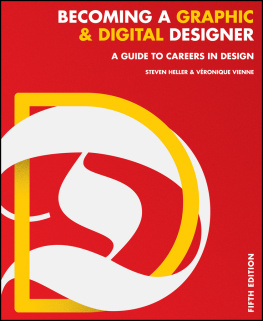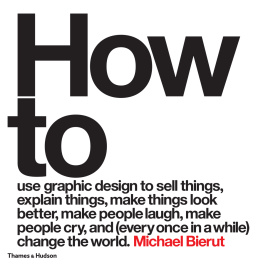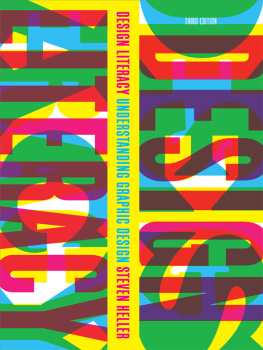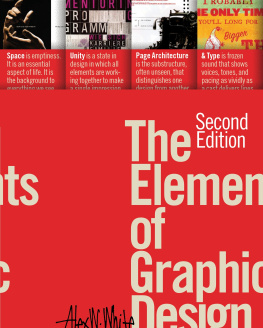
Copyright 1947 by Paul Rand.
Foreword to the New Edition copyright 2014 by Michael Bierut.
All rights reserved. No part of this book may be reproduced in any form without written permission from the publisher.
Library of Congress Cataloging-in-Publication Data available.
ISBN: 978-0-8118-7544-8 (pb)
ISBN: 978-1-4521-3065-1 (ebook)
Original edition published by Wittenborn Schultz, New York, 1947.
Third edition published by Studio Vista, London, 1970.
This edition published by Chronicle Books, San Francisco, 2014.
Set in Linotype Bodoni Book
Chronicle Books LLC
680 Second Street
San Francisco, CA 94107
www.chroniclebooks.com
Foreword to the New Edition
When Paul Rand sat down in 1947 to write the book that would become Thoughts on Design, he was thirty-three years old. The designer, born in Brooklyn and largely self-taught, was already a sensation. Appointed chief art director at the agency William H. Weintraub & Co. just six years before, he was credited with revolutionizing the clichd and buttoned-down world of Madison Avenue by introducing the bracing clarity of European modernism. His signature appeared on book covers, posters, and ads.
He was young. His logos for IBM, ABC, and Westinghouseall would be incorporated in the books subsequent editionswere still in the future. So were his induction into the Art Directors Club Hall of Fame, his position on the faculty at the Yale School of Art, the AIGA Medal, and all the accolades that would establish him as his countrys greatest designer by the time he died in 1996. Thirty-three years old was, perhaps, early for a book, but Rand was ready.
Paul Rand admitted all his life that he was insecure as a writer. It was his passion for his subject that made him such an effective one. In his day job on Madison Avenue, he had learned the virtues of saying more with less. As a result, Thoughts on Design is almost as simple as a childs storybook: short, clear sentences; vivid, playful illustrations. Ostensibly, it is nothing more than a how-to book, illustrated with examples from the designers own portfolio. But in reality Thoughts on Design is a manifesto, a call to arms and a ringing definition of what makes good design good. This, perhaps, has never been said better than in the books most quoted passage, the graceful free verse that begins Rands essay The Beautiful and the Useful. Graphic design, he says, no matter what else it achieves, is not good design if it is irrelevant.
Lszl Moholy-Nagy said of Paul Rand, He is an idealist and a realist, using the language of the poet and business man. That balance between passion and practicality was never displayed better than in Thoughts on Design. Its message is still relevant. We are lucky that the designers of today and tomorrow have this new edition.
Michael Bierut, New York City 2014
Preface to the Third Edition
In this edition of Thoughts on Design, the writer has made certain emendations. However, these do not materially alter his original thoughts or intentions. It is for the purpose of clarifying some of the ideas and enriching the visual material that a portion of the text has been revised and a number of illustrations have been replaced.
When this book was first written, it was the writers intention to demonstrate the validity of those principles which, by and large, have guided artists (designers) since the time of Polycletus. The author believes that it is only in the application of those timeless principles that one can even begin to achieve a semblance of quality in ones work or understand the transient nature of the fashionable. It is the continuing relevance of these principles that he wishes to emphasize, especially to those students and designers who have grown up in a world of pop and minimal art.
The author is indebted to all the advertisers, publishers, and manufacturers who have provided the opportunities for creating the visual material shown in this book. He also wishes to express his thanks to the typesetters and proofreaders for their help, and to the publishers for making a new edition of this book available.
P. R., Weston, Connecticut January 1970
Preface to the First Edition
This book attempts to arrange in some logical order certain principles governing contemporary advertising design. The pictorial examples used to illustrate these principles are taken from work in which I was directly engaged. This choice was made deliberately and with no intention to imply that it represents the best translation of these principles into visual terms. There are artists and designers of great talent whose work would be perhaps more suitable. But I do not feel justified in speaking for them nor secure in attempting to explain their work without any possibility of misrepresentation. This is not to say that this book is purely the result of my efforts alone. I am indebted to many peoplepainters, architects, designers of past and presentfor many theories and concepts. Many philosophers and writers, particularly John Dewey and Roger Fry, have helped to crystallize my thinking on the subject and to accelerate such progress as I have made. I have tried to pay my debt by quoting some of them.
P. R., New York City January 1946
The Beautiful and the Useful
Graphic design
which fulfills esthetic needs,
complies with the laws of form
and the exigencies of two-dimensional space;
which speaks in semiotics, sans-serifs,
and geometries;
which abstracts, transforms, translates,
rotates, dilates, repeats, mirrors,
groups, and regroups
is not good design
if it is irrelevant.
Graphic design
which evokes the symmetria of Vitruvius,
the dynamic symmetry of Hambidge,
the asymmetry of Mondrian;
which is a good gestalt;
which is generated by intuition or by computer,
by invention or by a system of co-ordinates
is not good design
if it does not co-operate
as an instrument
in the service of communication.
Visual communications of any kind, whether persuasive or informative, from billboards to birth announcements, should be seen as the embodiment of form and function: the integration of the beautiful and the useful. In an advertisement, copy, art, and typography are seen as a living entity; each element integrally related, in harmony with the whole, and essential to the execution of the idea. Like a juggler, the designer demonstrates his skills by manipulating these ingredients in a given space. Whether this space takes the form of advertisements, periodicals, books, printed forms, packages, industrial products, signs, or TV billboards, the criteria are the same.
That the separation of form and function, of concept and execution, is not likely to produce objects of esthetic value has been repeatedly demonstrated. Similarly, it has been shown that the system which regards esthetics as irrelevant, which separates the artist from his product, which fragments the work of the individual, which creates by committee, and which makes mincemeat of the creative process will, in the long run, diminish not only the product but the maker as well.
John Dewey, commenting on the relationship between fine art and useful or technological art, says: That many, perhaps most, of the articles and utensils made at present for use are not genuinely esthetic happens, unfortunately, to be true. But it is true for reasons that are foreign to the relation of the beautiful and useful as such. Wherever conditions are such as to prevent the act of production from being an experience in which the whole creature is alive and in which he possesses his living through enjoyment, the product will lack something of being esthetic. No matter how useful it is for special and limited ends, it will not be useful in the ultimate degreethat of contributing directly and liberally to an expanding and enriched life.
Next page







